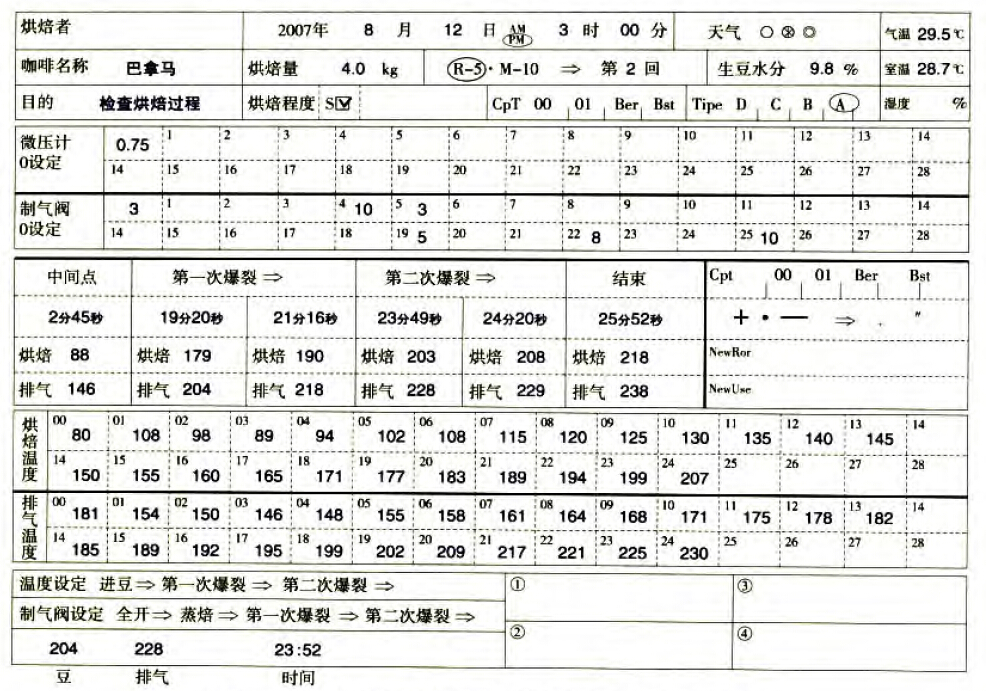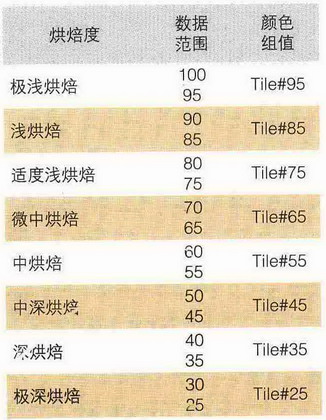The methods and advantages and disadvantages of testing coffee cups
The significance of cup test is to evaluate and compare several different kinds of coffee at the same level. It is also an important course in coffee training and barista training. Next, let's explore the secret of coffee cup testing with Mr. Hu of Baitianhui Coffee training School.
A cup test (Cup Testing) used to finally confirm the taste of coffee
No matter how well one speaks or how skilled he is, the most important thing is the taste of the coffee in the cup. If the coffee tastes pretty bad, then theory and technology are empty talk.
The final procedure for confirming the taste of coffee is called a "cup test", but this procedure is not just a random try. The subjective judgment and feeling of "this cup of coffee is too sour" can make people confused and can't make people think about how to improve roasting.
Why does it produce a strong sour taste? To find out the cause directly, you must start from the first step of the baking process, where you can see the importance of the baking record card (schedule 1). If there is no baking record, even if the ideal work is baked, there is no reference basis for baking the same thing next time; in addition, there is no objective basis for where to make what change and how to change.

Schedule 1 5 kg baking record card of Fuji Royal Roaster (Panama)
The cadets of Paradise barista training often ask questions about raw beans. Here, Mr. Hu will attach a baking record card for both raw and roasted beans, as well as a cup test record card. in this way, you can see at a glance what the problem is. This is why the cup test needs to be matched with the baking record card.
All kinds of cup measurement methods
"Cup Test" (Cup Testing. Or Cupping, Tasting, Cup
Tasting, etc.) there are a variety of methods, because there are no uniform rules in the world, so the producing country, consumer country, enterprise or individual can choose the appropriate cup testing method according to their own situation. But generally speaking, the approach is derived from the "Brazilian style".
So, what is the Brazilian cup test? Next, Baitianhui Coffee School will introduce the Brazilian cup test to you.
a. Brazilian cup method
First of all, grind the roasted coffee moderately, put 10 grams into the cup and inject 150 milliliters of hot water. The roasting degree of coffee is about 65% of the value of "Agtron" (schedule 2), which is about the degree of "cinnamon roasting" (light to moderate roasting in the United States). "Agtron" is the baking degree index mainly used in the United States, which is measured by a special colorimeter.
Then, stir the coffee powder soaked in hot water with a spoon to smell the fragrance. The next step is to remove the foam and scoop a spoonful of coffee liquid into the mouth with a test spoon. To confirm the defects of the coffee liquid, suck the liquid into the upper jaw and let the coffee liquid spread out in a fog in the mouth. It's not very elegant, but it confirms the smell.
Coffee is graded according to this series of sensory reviews, based on "Soft", "Hard" and "iodine". "mild" refers to the soft and elegant sour taste and strong mellow, "difficult" refers to the astringent taste like persimmon, "iodine taste" is the taste of carbonic acid and so on.

Schedule 2 distinguishes the baking degree according to SCAA's "Agrton" method
The above is a sensory review of the Brazilian cup test, but it has become unpopular recently because consumer countries (especially the United States) believe that "Brazilian evaluation criteria do not know the flavor characteristics and advantages associated with the taste of coffee."
Brazil is not ignorant of the comments of consumer countries, they also have something to say. The reason is that the main purpose of the cup test in Brazil is to find out the defective taste, not to evaluate the personality and advantages of coffee. The method of finding defects and grading them by Brazilian cup test is called "negative cup test" (
Negative Testing); on the contrary, it is called "positive cup test" (Positive Testing) in a positive way to evaluate the characteristics and personality of coffee.
Each of the two methods has its own purpose and use, but today is the era of high-quality high-quality coffee. In the past, the negative evaluation of looking for defects has been meaningless, instead, the positive evaluation of coffee personality and aroma is the mainstream of the times.
The United States, the largest importer of Brazilian coffee, has changed its evaluation method from "negative cup test" to "positive cup test", and Brazil and Brazil have been forced to significantly revise their evaluation benchmark. Brazil, which originally used the most common commercial coffee as the main force of the international market, finally adopted "Cup" after several failed experiments.
The evaluation method of "of Excellence (COE)" has spread all over the world through Brazilian manufacturers. Thus it can be seen that the "positive cup test" method has really become the mainstream.
Brazilian sensory examination is generally applicable to most consumer countries in the world. The baking degree used in the cup test is set to "cinnamon baking" because it does predict the taste change between shallow baking and deep baking. With the deeper the roasting degree of coffee, the more volatile ingredients, the taste will change, so choose the roasting degree before volatilization, that is, shallow roasting to measure the cup.
In fact, there is another reason. The largest importer of Brazilian coffee is the United States. The United States entered the 1980s with light roasting, the heyday of American coffee. It is only natural that Brazil, the producer, will match the American habit of using shallow baking during cup testing. If the baking method in the United States was deeper at that time, then the Brazilian cup would have been baked more deeply.
But Paradise Coffee School believes that it is quite risky to change coffee suitable for light or cinnamon roasting to French or Italian roasting and add it to the menu. Because even if the taste is excellent after light roasting, it does not mean that the coffee is suitable for deep roasting.
Therefore, the baking degree of cinnamon measured by Brazilian cup is not necessarily used in cup testing, and it is better to use deep roasting in coffee cups suitable for deep roasting.
The defective taste of raw beans can be clearly found after shallow baking. Unlike immature beans, which are as difficult to distinguish as ordinary beans once they are deeply baked, shallow baking can easily tell the difference from their appearance.

Schedule 3 coffee cup taste ring
When using raw beans for the first time, Mr. Hu of Baitianhui Coffee training suggested that first bake it in a shallow degree, then test it in a cup, and then bake it to a predetermined baking degree if it tastes good, and then test it again. Shallow baking cup test has considerable advantages, but just knowing the taste of defects does not mean that you know the taste of the whole. No matter what kind of coffee needs to be tested, it is best to bake it to the second burst period, because it will produce rich aroma and delicacy in the early stage of the second burst.
Although the aroma evaluation of SCAA (American Fine Coffee Association) uses the roasting degree of about Agtron50 (city roasting), the rich flavor of coffee will not appear until it enters the second burst period. I hope you can understand this.
The following is a comparison of cup testing methods between SCAA and Paradise Coffee training:
B.SCAA cup measuring method
Put moderately ground coffee powder (about 8 grams) in the cup and shake and smell the aroma (Fragrance). Pour 150 milliliters of hot water and boil for 3 minutes. Cut open the dome-shaped layer of coffee powder with a spoon. Now put your nose close to the cup and smell the freshly brewed coffee (Aroma).
Next, use a spoon to remove the foam from the upper layer of the coffee liquid, rest for a while, then scoop a spoonful of the coffee liquid with a spoon, and inhale the coffee into the mouth, leaving the coffee liquid in a fog in the mouth. Confirm the aroma and spit out the coffee liquid. Evaluate the taste of coffee when it is slightly hot, cold and cooled in order, and the items to be evaluated are as follows:
Dry aroma Fragrance (aroma of coffee powder)
Wet aroma Aroma (aroma of coffee liquid)
Sweet Sweetness
Refreshing sour Acidity
Flavor Flavor
c. Baitianhui barista training recommends coffee cup test method
Prepare for moderate grinding of 10 grams of coffee powder, about 85 ℃ of hot water 150ml, to the general filter paper trickling filtration method to make one-person coffee, the extracted coffee liquid into the cup, test spoon cup test, after the test, the coffee liquid is discarded, although the next cup test is not much different, it can still be seen that the unique coffee cup testing method of Paradise Coffee training is different from that of Brazilian type or SCAA type. The main differences are as follows:
1. The baking degree is above the second bursting.
two。 Use of extraction apparatus
3. Confirm the number of projects
The Brazilian cup test is to test the coffee containing defective beans and then judge whether it belongs to the scope of export. However, the coffee cup test method used in Baitianhui coffee training has been selected by hand from the very beginning, so the taste of defective beans will not be tested, so the cup test items are less.
Compared with the confirmation of defective taste, our main focus should be on the balance of taste, which is of more practical significance for opening a shop, plus there is no need for any special equipment or equipment, and cup testing can be carried out anytime and anywhere. This is also where the coffee cup testing method of Baitian coffee training is better than other kinds of cup testing methods. The most important thing is that the cup test can be carried out continuously, so convenience is very important.
In the coffee cup test method used by Baitianhui Coffee School, the following items are something beginners must learn to judge.
Bitter taste
Sour taste
sugariness
Astringent taste
Flavor
Concentration
"Flavor" can also be expressed as "fragrance". Flavor mainly refers to the taste when it is contained in the mouth. The smell smelled by the nose is obviously different from that contained in the mouth.
When it comes to "concentration", it may be a little difficult to understand. in fact, the same amount of coffee liquid extracted with the same amount of coffee powder will have a strong or light taste.
One of the items evaluated in the SCAA cup test is the "alcohol thickness" (Body), which is tested by instantly slipping the coffee through the mouth and judging its touch in the mouth. The "concentration" mentioned here is something deeper, because the taste, such as thickness or viscosity, all comes from the fat, fiber and protein contained in the coffee liquid, which is less melted with the human coffee liquor. the coffee will be light.
Compared with the three cup measuring methods, the most significant difference lies in the "use of extraction apparatus".
Both Brazilian and SCAA cup tests only pour hot water into coffee powder without using special tools. This is to cooperate with most companies and consumers, but although this way can confirm the various flavors and aromas contained in coffee powder, the balance of taste is not known.
Baitianhui Coffee training School has been studying and working hard to choose the cup test method that is closest to the customer level as far as possible. If the cup test is different from the way customers usually drink coffee, we can't explain to customers that "this kind of coffee will taste like this again when it's roasted like this." Small-scale coffee shops with limited customers are more suitable for cup testing with daily utensils and methods.
Important Notice :
前街咖啡 FrontStreet Coffee has moved to new addredd:
FrontStreet Coffee Address: 315,Donghua East Road,GuangZhou
Tel:020 38364473
- Prev

Analysis of the operation flow of Italian coffee machine by the technology of brewing coffee
Italian coffee machine operation flow 1, preparation, check the equipment; 2, warm cup (warm cup plate, hot water); 3, remove and clean the handle (dry towel, brush); 4, grind, drop powder, fill, press and clean the handle; 5, open the extraction key for 2 seconds to observe the air pressure and water pressure parameters; 6, lock the handle; 7, open the extraction key, read the second timing, take the cup, observe the flow rate. PS:2030 seconds 25
- Next

Boutique Coffee Common sense Ice drop Coffee originated in Europe
Ice drop coffee originated in Europe, because the coffee distiller was invented by the Dutch, so some people call it DUTCH COFFEE, espresso or water drop coffee. Ice drop coffee depends on its compatibility with water, which is mainly caused by condensation and natural osmotic water pressure.
Related
- Beginners will see the "Coffee pull flower" guide!
- What is the difference between ice blog purified milk and ordinary milk coffee?
- Why is the Philippines the largest producer of crops in Liberia?
- For coffee extraction, should the fine powder be retained?
- How does extracted espresso fill pressed powder? How much strength does it take to press the powder?
- How to make jasmine cold extract coffee? Is the jasmine + latte good?
- Will this little toy really make the coffee taste better? How does Lily Drip affect coffee extraction?
- Will the action of slapping the filter cup also affect coffee extraction?
- What's the difference between powder-to-water ratio and powder-to-liquid ratio?
- What is the Ethiopian local species? What does it have to do with Heirloom native species?

